Cardiometric study of the cardiovascular system performance under the influence of prolonged smoking and some other stresses
Автор: Rudenko M.Y., Deberdeev M.A., Chepiga A.O.
Журнал: Cardiometry @cardiometry
Рубрика: Editorial
Статья в выпуске: 31, 2024 года.
Бесплатный доступ
Using an example of one patient, who smoked, who was found in some other stressful situations for 50 years and later suffered an acute myocardial infarction, the dynamics of the state of the cardiovascular system in cardiometric studies is shown herein. The results showed a direct relationship between the deterioration of the cardiovascular system performance and long-term smoking accompanied by some other stress types. Using the diagnostic capabilities of cardiometry, it was possible not only to avoid open heart surgery in the patient in question, but also to restore the cardiovascular system performance after two stenting operations. It has been shown that for the restoration of the cardiovascular system performance after an acute infarction, along with stenting, constant breathing exercises using one of the widespread conventional breathing training systems are extremely important.
Cardiovascular system, infarction, cardiometric examination, long-term smoking, stress, stenting
Короткий адрес: https://sciup.org/148328641
IDR: 148328641 | DOI: 10.18137/cardiometry.2024.31.918
Текст научной статьи Cardiometric study of the cardiovascular system performance under the influence of prolonged smoking and some other stresses
Mikhail Yu. Rudenko, Viacheslav M. Tyutyunnik, Elena N. Rogova, Murat A. Deberdeev, Artem O. Chepiga.Cardiometric study of the cardiovascular system performance under the influence of prolonged smoking and some other stresses. Car-diometry; Issue 31; May 2024; p. 9-18; DOI: 10.18137/cardiom-etry.2024.31.918; Available from: issues/no31-may-2024/cardiometric-study-cardiovascular-sys-tem
Human individuals have been smoking throughout their history on the Earth. But there is still no clear answer about dangers or benefits of smoking, mainly because smoking is almost always accompanied by stress, often by alcohol, unhealthy foods, poor-quality water drinking and polluted environmental air. In addition, the state of a human body is influenced by its genetic history, lifestyle, level of immunity and some other factors, and all this together acting at the same time. In this reality, it is still extremely difficult to experimentally isolate and study an individual effect produced by each factor in question on the body.
Cardiometry has allowed us to reveal the mechanism of the influence produced by smoking on the cardiovascular system performance using an exemplary case with one patient, who was monitored at two stages: first under the conditions, all other things being equal, then with systematic monitoring of each of the above listed factors.
Unlike cardiology, cardiometry records the influence made by the systemic and pulmonary circulation on each other. It is very important to consider that in pulmonary circulation the role of the lungs is decisive. And smoking specifically affects the breathing cycle, which correlates with the heart rate cycle as 1:4. There are in general four heartbeats related to every breathing rhythm. If we change breathing, increasing its period, then desynchronization between the systemic and pulmonary circulation occurs that is manifested on the rheogram in the slow ejection phase in the form of stagnation of blood flow in terms of insufficiency of blood flow in the phase of filling of the coronary arteries. As a result, the coronary arteries narrow. Continued smoking over many years may lead to their occlusion.
In [1, p. 136-147], the diagnostics of the actual coronary blood flow using ECG and rheogram is described in detail. Figure 1 given herein shows the norm and deviations from the latter in the shape of the rheogram in the slow ejection phase. The flat top of the rheogram (the lower curves) indicates insufficient blood volumes to fill the coronary arteries, leading to their occlusion.
DESCRIPTION OF PATIENT CASE AND STENTING OPERATIONS
Patient V., born in 1949, has a sound genetic history: his Greek ancestor grandparents practical-
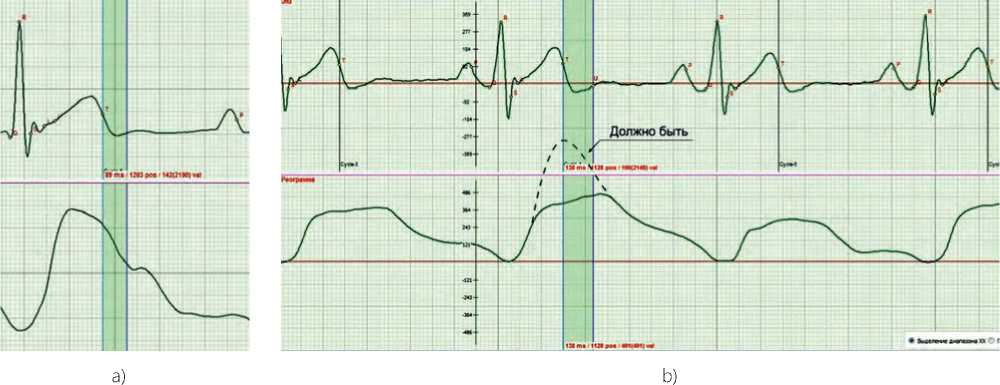
Figure 1. Normal filling of the coronary arteries (a) versus insufficient blood volumes to fill the coronary arteries due to improper breathing
ly did not get sick and were long-livers, and his ancestors, despite their not perfect health state, were also long-livers. So, his father lived to be aged 93, although after 85 he suffered three heart attacks and two strokes. Patient V.’s lifestyle was far from that theoretically correct: from his youth he was intensively engaged in scientific research and teaching at a number of universities both in Russia and abroad (he occasionally went in for sports), often traveled throughout the world (continuous change of water, air and food), slept 4-5 hours a day until he was 70 years old, married several times, smoked continuously and heavily for 50 years, and drank alcohol just as often and heavily. However, the level of his immunity was quite high, he very rarely suffered from colds, almost did not take any medications, never had surgery; his BMI was always normal, and he had good physical strength.
In February 2023, after intensive night smoking while completing a scientific article, the next morning, with a diagnosis of acute myocardial infarction of the anterior wall of the left ventricle with ST segment elevation and the formation of a pathological Q wave, patient V. was delivered to the hospital by ambulance, where he that same morning, using coronary angiography, was diagnosed with the following: a three-vessel lesion, stenosis of mouth of the left main coronary artery, hemodynamically significant, bifurcation-complicated, subtotal stenosis of the anterior descending artery with the first diagonal artery, hemodynamically significant stenosis of the right coronary artery (90%) and the circumflex artery (80-85%) and the intermedia artery (75%); concomitant atherosclerosis of the 10 | Cardiometry | Issue 31. May 2024
aorta against the background of risk level 4 dyslipidemia; chronic heart failure with a preserved ejection fraction of 65%. Immediately, in cardiac surgery unit, under X-ray control, bifurcation stenting of the anterior descending artery with the first diagonal artery was performed (3 Calypso stents 3.5x24 mm, 2.75x24 mm and 3.5x28 mm).
A week after the surgery, a telemedicine consultation for the above patient was provided with the Federal State Budgetary Institution “The National Medical Research Center for Cardiovascular Surgery named after. A.N. Bakulev”, as a result of which it was recommended: “Given the acute phase of myocardial infarction, drug therapy is currently indicated.”
Within 12 days at the hospital, patient V. received medication treatment using the following: Heparin, Acetylsalicylic acid, Brilinta, Bisoprolol, Enalapril, Atorvastatin, Spironolactone and Omeprazole. During his treatment, the patient V.’s condition improved, and he was discharged to be followed-up by the local clinic institution. However, the general condition of the heart vessels, calcification of the walls of the aortic root, fibrous rings, and the aortic and mitral valves were decisive for the responsible medical doctor to strongly recommend bypass surgery for the patient in question.
Immediately after the operation, the second phase of the patient’s life with monitoring of his health began [2-7]: smoking and alcohol consumption were completely stopped, nervous stress was eliminated, sleep and wakefulness were adjusted, a transition to dietary nutrition was made, and all recommended medications were strictly taken by the above patient.
CARDIOMETRIC STUDIES
IN THE PRE-INFARCTION PERIOD
More than 10 years before his infarction, patient V. periodically underwent cardiometric studies, without indications for this, since there was no problem with his heart performance, i.e. that was performed for the purpose of preventive monitoring of his health status. In December 2010, a contour analysis of photoplethysmography at a pressure of 123/79 showed a stiffness index of 2.2% and exhibited generally the good arterial condition; a re-analysis after 4 years at a pressure of 120/75 delivered a stiffness index of 5.3% and showed still the good condition of the arteries.
In 2011, the first recordings were made using the original version of the Cardiocode device, as shown in Figure 2 herein, from which it could be seen that in the sitting position the blood vessels in the above patient demonstrated their almost ideal condition, but in the lying position, in the slow ejection phase, the rheo-gram had a flat shape. This indicates that breathing in this position is not normal. This is also evidenced by the ejection fraction: when lying – 70%, and when sitting – 64%, i.e. in the lying position observed is an increase in the load on the heart.
The next study was carried out at the beginning of 2013 (see Figure 3 herein), which showed even worse respiratory conditions, and metabolic therapy was administered. The clear-cut effects produced by smoking have been revealed after 40 years of tobacco consumption.
The recorded curves dated 2015 (see Figure 4 herein) exhibited stagnation of the blood flow during the filling phase of the coronary arteries; the rheograms had a flat shape. Ejection fraction data were obtained as follows: when lying – 76%, and when sitting – 70%.
Some conditions have been found that have led later to an occlusion of the coronary arteries. Cardiac ultrasonography in October 2016 showed sclero-de-generative damage to the aortic root wall, aortic valve calcification, biventricular hypertrophy, and some left atrial dilatation. In March 2017, an electrocardiogram revealed a moderate alteration in the left ventricular myocardium. Those data indicated an emergency case with the need to stop smoking and maintain the proper lifestyle, but patient V. did not follow that way, relying on his powerful body, and continued his stressful life pattern. In 2021, the unfavorable disease process
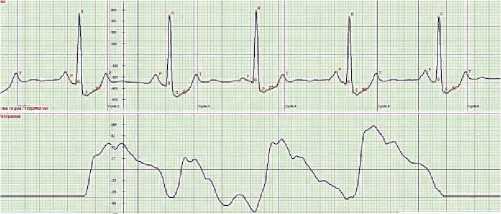

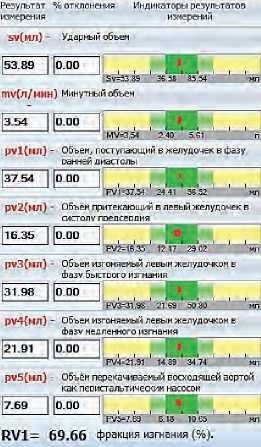
08/08/2011 lying
Figure 2. Cardiograms and rheograms of patient V. recorded in mid-2011
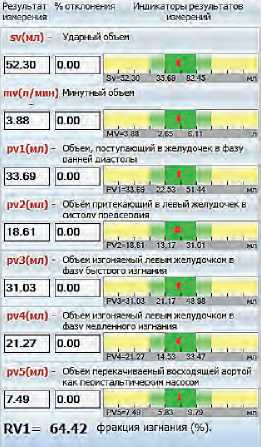
08/08/2011 sitting


%
Результат отклонен. Индикаторы результатов измерений, измерен. от нормы индивидуальна» макс, и мин. норма.
II JB
ооо
е за
1 «
SV(ml) - ударный Объем
<вйвК1вЬнайюп1иг1±ОНАС SOblP аЛВ(Щ|) ~ OSTC'i чСавн ибЬвкзинвввияи аосхоИагНен воЬхОн ХЭК иеЬнсхвирдмнвсючи нэсОСОП
' х 1 чэ____ эз аэ
71 06 0.00

зг'ов
0 00
ьмИ -rwen кЬсеннэюкнвняни«вя|Г|квйКйонй5и вс^^ пзгнвнна
MV(I) - Мин утный объем

PV1(ml) - Объем крови, поступающий s желудочек в фазу ранней диастолы, характеризующий п рисасывающую функцию желудочка .
ai so
0'00
ьлз(ш|) - ОО₽йи кЬоен нэючаеиям иевяи «шХ'ЗаййойТйряЩ^^^ю нзшэнчв^
50.90 0.00
PV2(ml) - Объём крови притекающий в левый желудочек совратительную функцию предсердия

в систолу предсердия, характеризующий
3514_______ о 00 ___________
СОКЬелнхвирнЛю фАнкОнЮ |1йЙСв1ЯЭДв' . . .
- пажёй кЬоеп цЬшвквюпТчн в uSBPiN жеиАЧонек в снсьоиА иЬвЧсеЬЧна' хэоэк1вЬнзЛЮП1НВ ' 56'08
20.1 Б О ОО ~
PVKml) - Объем крови изгоняемый левым желудочком в Фазу быстрого i
гз so
ПэнЖйввй1ЙХю'фХн''Н^^
hAJlwiboeFsweboaN' чостЛиэюгЛНМВжвиМонек вфээХЬэнмёВ’Тявсхоия хвЬэивЬнэЛклбнч
338 НО
42 № ООО
W4H) • О бъ ем крови изгоняемый левым желудочком а фазу медленного икания
ese
0'00
ЙЙ - pyMHkiMPi» ослеп
28 89 О М ЦЩ^Ц
PV5(ml)- Объем крови перекачиваемый восходящей аортой как перистальтическим насосом, характеризующий тонус аорты___________
80'3^1
ё/ЙйнУ^АЙёБййёоедеи

0.00
7.57 13.10
HirtdjW
ЬСЗЛинЬЯ I
Oi. Hobwpi
ПЛОХО ЕЮ1Г
шганхийййлхрияи иякс н итпг ноЬия1 НТШнКЯХОЬИ ОМАШМУ ЮИ lUWGlJCHHB'
01/25/2013 lying
01/25/2013 sitting
Figure 3. Cardiograms and rheograms of patient V. recorded at the beginning of 2013
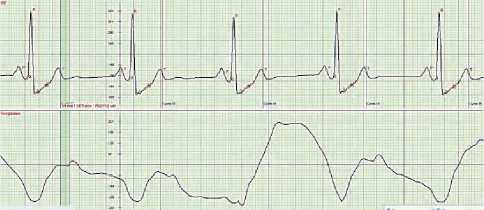



02/06/2015 lying
02/06/2015 sitting
Figure 4. Cardiograms and rheograms of patient V. recorded at the beginning of 2015
demonstrated its further progress (see Figure 5 here- In the morning of February 10, 2023, patient V. unin): ejection fraction data were recorded as given be- derwent stenting surgery. After his discharge, the seclow: when lying – 74%, and when sitting – 70%. ond stage of our research study was started.

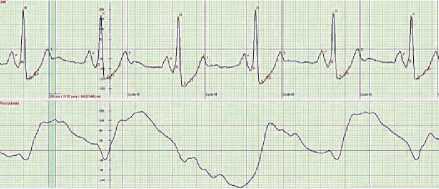
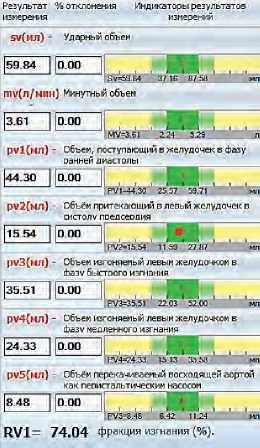
09/30/2021 lying
Figure 5. Cardiograms and rheograms of patient V. recorded in September 2021

09/30/2021 sitting
CARDIOMETRIC STUDIES
IN THE POST-INFARCTION PERIOD
The patient’s discharge summary report dated February 21, 2023 contained the following information: against the background of the treatment, the patient’s condition improved, chest pain did not recur, and the hemodynamic data remained stable.
Upon discharge, the summary report prescribed medications for continuous use as listed below: Bi-soprolol 5 mg in the morning (target heart rate of 55-60 beats/min at rest), Perindopril 4 mg once a day under blood pressure monitoring, Acetylsalicylic acid 100 mg in the evening, Ticagrelor 90 mg in the morning and evening, Atorvastatin 80 mg in the evening under lipid profile monitoring (target low-density lipoprotein values of 1.4 mmol/l with subsequent dose titration), Spironolactone 50 mg in the afternoon with creatinine monitoring, Panto-prazole 20 mg 30 minutes before dinner. Patient V. took all these medications regularly for the first two months after the operation, later gradually removed the medical drugs which lowered blood pressure from his treatment regimen. The remaining medications were taken for a year.
After discharge from the hospital, patient V. was under the supervision of his cardiologist, who recommended open-heart bypass surgery to him. Three other independent cardiologists confirmed that recommendation within three months after the completed operation, although echocardiography dated 02.20.2023 compared with echocardiography dated 02.10.2023 indicated positive dynamics in the form of disappearance of the areas of impaired local contractility of the left ventricle, an increase in ejection fraction to 65%, disappearance of the pulmonary hypertension; the concomitant diagnosis was specified as follows: aortic atherosclerosis. The next ECG dated 03/06/2023 showed incomplete blockade of the right bundle branch and positive dynamics compared to previous ECGs: anterior widespread non-Q myocardial infarction, subacute stage.
At the beginning of March 2023, we made cardiometric recordings (see Figure 6 herein), which showed that the coronary blood flow did not improve, signs of thrombus formation began to appear, and the ejection fraction increased: when lying – 77%, and when sitting – 76%. It could be seen that the overdose of vasodilators significantly increased the diastolic pressure
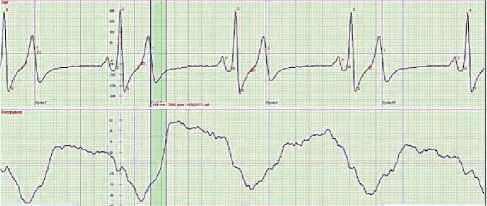
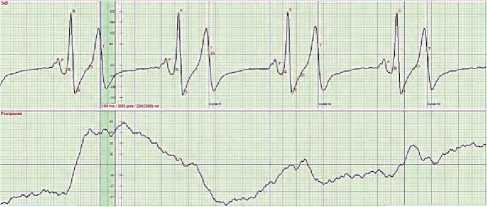

03/08/2023 lying
Figure 6. Cardiograms and rheograms of patient V. recorded in March 2023

03/08/2023 sitting
in the sitting position. The hemodynamic data were unstable from cycle to cycle, and the load on the heart has increased.
In the second half of March, the patient’s ECG was recorded and cardiac echography in the patient was completed at the clinic again. His ECG dated March 16, 2023, in comparison with that recorded ten days earlier, showed the absence of ventricular extrasystole and the normal sinus rhythm. The ultrasonic examination of the heart dd. March 20, 2023 revealed the persistence of the sclerotic changes in the walls of the aortic root, which were compacted and thickened; the aortic valve was compacted, focally calcified; slight hypokinesis of the middle and apical anteroseptal segments were found; the global contractility of the left ventricle was found to be satisfactory; the left ventricular ejection fraction was 61%.
our previous experience has shown that it is just the normalization of breathing that may solve cardiac problems. To maintain the functions of the heart, we recommended drugs produced by Vitaukt: Cardiomag and Diosclefit.
The classic ECG dated April 27, 2023 showed positive dynamics compared to the previous ECG measurement.
Cardiometric examinations completed in early May (see Figure 8 herein) showed an improvement in hemodynamics in the lying position (ejection fraction – 76%): that was the first success. But however in the sitting position, the hemodynamic instability remained, and an ejection fraction of 75% indicated an increased cardiac load. For example, in athletes this fact relates to a hypertrophied heart.
The ECG dated May 10, 2023 did not reveal any changes compared to the previous ECG measurements. The patient’s sonographic examination of the heart on the same day, carried out for comparison by a private clinic, showed the normal sinus rhythm, mild calcification of the walls of the aortic root, the aortic crescents, and the mitral valve leaflets. Mitral regurgitation, which was found at the initial stage,
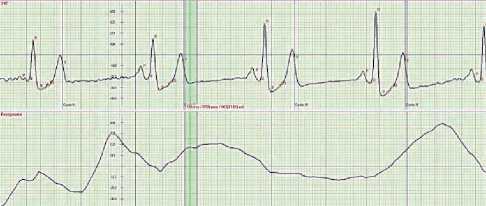

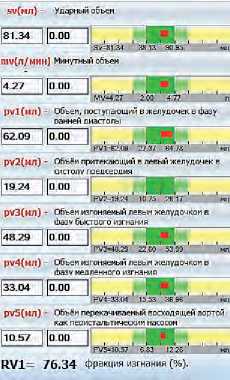
04/09/23 lying
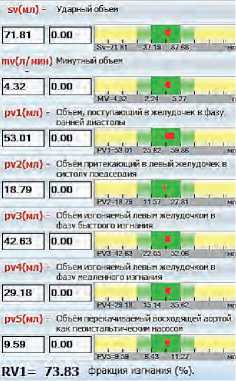
04/09/23 sitting
Figure 7. Cardiograms and rheograms of patient V. recorded in April 2023

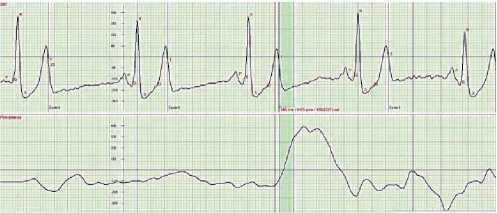
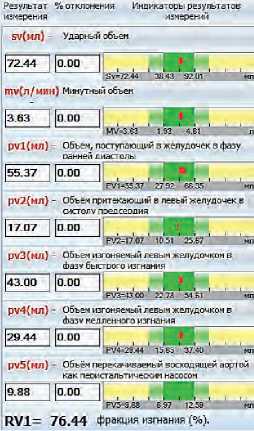
05.05.23 lying
Figure 8. Cardiograms and rheograms of patient V. recorded in May 2023

05.05.23 sitting
and diastolic dysfunction of the left ventricle (type 1 disorder) remained unchanged. The global systolic function of the left ventricular myocardium was not impaired.
One and a half months after the completed breathing exercises, the cardiometric examination showed the normalization of the hemodynamic data in each cardiac cycle (see Figure 9 herein). The ejection fraction data decreased (lying – 72%, sitting – 70%). However, the uninterrupted medication showed an overdose: an early rise in the rheogram indicated dilatation of the aorta. Hence the elevated diastolic pressure parameters were taken.
The responsible cardiologists insisted on recommending bypass surgery, and the patient again sent the latest examination data for a telemedicine consultation at the Federal State Budgetary Institution “National Medical Research Center for Cardiovascular Surgery named after A.N. Bakulev.” The response dated 07/05/2023 stated the following: “To identify further treatment tactics, it is necessary to perform a repeat coronary angiography and attach the latest ECHO-CG and ECG data to request for our consideration.” Due to the summer holidays, the surveys were delayed until the end of August 2023.
THE SURVEY RESULTS
WERE AS GIVEN BELOW
The ECG dated July 27, 2023 did not reveal any changes compared to the data dd. May 10, 2023. An examination by a cardiologist six months after the operation (08/11/2023) showed coronary heart disease in the form of angina pectoris FC 2. Long-term oral administration of the previously listed tablet drugs (doses reduced by half) and aerobic physical activity were recommended. Coronary angiography performed on August 15, 2023, showed no changes compared to the six-month imaging data: the three-vessel injury, hemo-dynamically significant stenoses of the intermedia artery 70%, the circumflex artery 85%, the right coronary artery 90%; the stents of the anterior descending artery and diagonal artery were patent, there was no restenosis available. Ultrasonography of the heart on August 30, 2023 showed focal calcification of the walls of the aortic root, the leaflets of the aortic and the mitral valves, and a slight increase in the size of the atria and the right ventricle. The contractile function of the left ventricle was preserved; the cardiac ejection fraction was 70%.
Taking into account the urgent recommendations of the responsible cardiologists and the neutral position of the Russian national leading center for cardio-
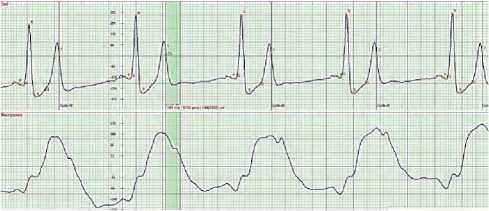
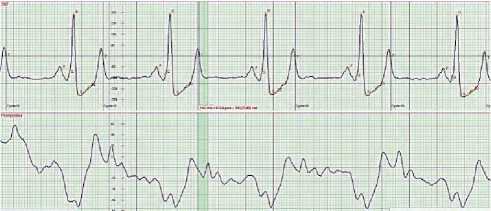
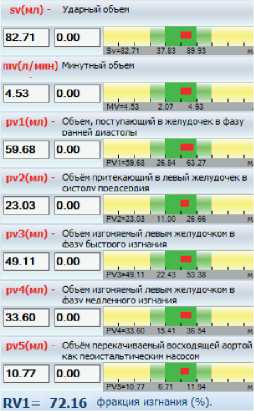
06/28/2023 lying
Figure 9. Cardiograms and rheograms of patient V. recorded at the end of June 2023

06/28/2023 sitting
vascular surgery, patient V. personally sought advice at the Federal State Budgetary Institution “FC Cardiovascular Surgery” (Penza, Russia). The response received on 09/05/2023 contained an invitation to an in-person consultation with possible hospitalization for coronary angiography on 10/03/2023. The required test results according to the examination standard were found to be without any special deviations from the norms.
An ultrasound examination of the heart (echocardiography) performed in Penza on 10/03/2023 showed satisfactory contractility of the left ventricular myocardium, the left ventricular ejection fraction (Simpson methid) was 65%, the pericardium was found not to have any specific features. Coronary angiography was performed on October 4, 2023 after the Allen test and puncture of the radial artery on the right. Then the following operation was performed: PTCA of PA with implantation of a CL-De 3.0-18 mm stent, PTCA of OA with implantation of a Cs-De 2.5-18 mm stent.
The discharge summary report dated 10/06/2023 states the following: the type of blood supply is right, the heart sounds are muffled, the rhythm is correct, heart rate is 75 beats/min, blood pressure is 130x80, and respiratory rate is 17 per minute. Outpatient treatment, follow-up by a cardiologist, diet, continuation of therapy are recommended: Acetylsalicylic acid 100 mg in the evening constantly, Clopidogrel 75 mg once a day for 12 months, Atorvastatin 40 mg per day constantly (strictly under monitoring of biochemical blood test data), Bisoprolol 5 mg in the morning, Fos-inopril 20 mg in the morning. The next coronary angiography is scheduled for 10/14/2024.
After 8 months of the completely changed way of life, patient V. felt well, gradually established his new healthy lifestyle pattern, returned to moderate acceptable physical activity, fully excluded smoking or alcohol, carried out scientific research only in the daytime, and slept at least 8 hours a day. He continued periodic exercises with the respiratory training system, but when he strongly bent forward and straightened sharply, dyspnea appeared for up to 10-15 seconds.
An ultrasound examination of the heart on November 16, 2023 showed slight hypertrophy of the left ventricular myocardium. No areas of local contractility impairment were identified; the contractility of the left ventricular myocardium was preserved. Left ventricular ejection fraction (acc. to Simpson method) was 66%.
The latest cardiometric studies in our cycle, carried out exactly one year after infarction (see Figure 10 herein), showed the restoration of hemodynam-

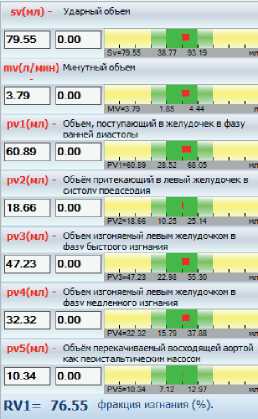
02/10/2024 lying
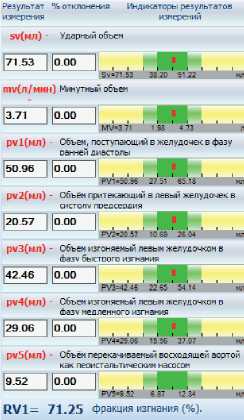
02/10/2024 sitting
ics in each cardiac cycle, as well as a sound vascular condition.
Patient V. continues to perform his breathing exercises and stretches his spine with the horizontal bar every day. As for medications, he continues to take Acetylsalicylic acid, Clopidogrel and Diosclefit.
CONCLUSIONS
-
1. Our cardiometric studies of the above patient case (with excellent initial health) for more than 10 years showed a direct relationship between the deterioration of the cardiovascular system performance and long-term smoking accompanied by some other stress kinds.
-
2. Using the diagnostic capabilities of cardiometry, it was possible not only to avoid open heart surgery, but also to restore the proper cardiovascular system performance.
-
3. It has been shown that for the restoration of the cardiovascular system performance after acute MI, along with stenting, constant breathing exercises using one of the widespread training systems are extremely important.
-
4. A description of the functioning modes of the healthy heart was first presented in [8]. It also describes methods for maintaining the sound cardiovascular system performance in childhood, in adults when going in for sports, as well as in elderly population.
Список литературы Cardiometric study of the cardiovascular system performance under the influence of prolonged smoking and some other stresses
- Rudenko MY. Cardiometry. Fundamentals of theory and practice: educational method. Manual for universities on specialty 05.30.02 "Medical biophysics" / MY Rudenko, et al. Taganrog; Moscow: Publishing House of the Institute of Chinese Medicine, 2020. 214 p. (Foundation for Outstanding Scientific Discoveries).
- Gromov YY, et al Intelligent digitalization of cardiovascular risks. Cardiometry. 2022;22:77-94. EDN: QGHNVZ
- Tyutyunnik VM. The human body's response to external influences: Nobel Prize in Physiology or Medicine for 2021. History of Science and Technology.2022;8:3-10. [in Russian].
- Tyutyunnik VM, Buchachenko AL. Molecular mechanism of the magnetic effects for elucidating magneto-chemistry of genes. Marcus International Symposium (Intl. symp. On Solution Chemistry Sustainable Development), SIPS 2022 by FLOGEN (Sustainability through Science & Technology). 2022.
- Filippov YA. Technologies for determining the functional and physiological state of a person. Bulletin of the Russian New University. Ser.: Complex systems: models, analysis, control. 2020(5):63-71. [in Russian].
- Buchachenko AL, Tyutyunnik VM. New frontiers in gene chemistry. Prospective areas of research in science and technology: Collective monograph. Ed. by Prof. VM Tyutyunnik. INIC Publ. House "Nobelistics", 2021. P.144-157. EDN: OIAGLE
- Rudenko MY, et al. The Crisis in Modern Medicine: How to Find Ways Out. Information systems and processes: collection of scientific papers / ed. by Prof. VM Tyutyunnik. INIC Publ. House "Nobelistics". 2017;16:59-64. EDN: ZEASON
- Rudenko MY, et al. Cardiovascular system of an a thlete. Cardiometric characteristics of physical capabilities before, during and after sports / Ed. by MY Rudenko. Taganrog, Moscow: IKM Publishing House, 2020. 160 p. ISBN: 978-5-86746-123-8


